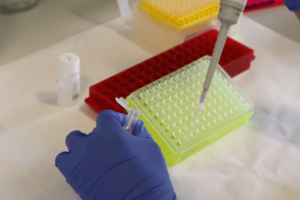IRSJD researchers have discovered an intergenerational inheritance mechanism in mouse models of childhood obesity
A study led by Dr. Josep Jiménez-Chillaron, a researcher at the Institut de Recerca Sant Joan de Déu and the University of Barcelona, suggests that hepatic steatosis could be intergenerationally inherited through paternal germ line microRNAs. Hepatic steatosis is a condition that is associated with childhood obesity. The results of this study have been published in the scientific journal Nutrients.
Hepatic steatosis is an excessive accumulation of fat in the liver, which can be caused by various factors such as excessive alcohol consumption or a diet rich in fats and sugars. Furthermore, this condition has been linked to childhood obesity, which affects millions of children worldwide and increases the risk of chronic diseases like type 2 diabetes or cardiovascular diseases.
The research team used a mouse model to investigate possible epigenetic mechanisms associated with intergenerational transmission of hepatic steatosis. The researchers observed that miRNA-201 and miR-457, two microRNAs, could be transmitted through the parents' sperm to their offspring, and could potentially carry information across different generations of mice.
MiRNA-201 and miR-457 play a role in obesity
MicroRNAs (miRNA) are small non-coding RNA molecules that regulate gene expression at the post-transcriptional level. In other words, miRNA binds to messenger RNA molecules and prevents them from being translated into proteins, which can impact brain function and the development of certain diseases. On the other hand, miRNA is involved in many biological processes such as cell differentiation, proliferation, apoptosis, etc., as well as in different pathologies, such as cancer, cardiovascular, or metabolic diseases.
The researchers observed that mice exposed to a high-fat diet showed an alteration in the expression of miRNA-201 and miR-457 in the liver. These two miRNAs could be involved in the regulation of lipid metabolism and could affect the pathogenesis of metabolic and endocrine diseases associated with a high-fat diet, promoting the development of hepatic steatosis. At the same time, both miRNA could be detected in the mice's sperm and in their offspring, which explains why the offspring of obese mice were also more likely to be obese.
"These results provide a new perspective on the intergenerational transmission of hepatic steatosis in mouse models with childhood obesity. We have identified two mRNAs that are transmitted through paternal inheritance via sperm and are likely to be involved in this inheritance." Said Dr. Josep Jiménez-Chillaron, the head of the Metabolic diseases of pediatric origin research group at IRSJD, says that. "Furthermore, these mRNAs could be potential therapeutic targets for preventing or treating this pathology and other diseases related to childhood obesity. And this could have significant implications for the prevention and treatment of these conditions in future generations."
Researchers found that these paternally transmitted miRNA could affect gene expression in the liver cells of offspring, potentially leading to the development of hepatic steatosis. However, further studies are required to understand the mechanisms of action.
An inheritance acquired through environmental factors
In this study, the results are part of a project on non-genomic inheritance of traits induced by environmental factors and their mechanisms. The research team is investigating how overfeeding can genetically influence and modify metabolism, leading to obesity and hereditary overweight.
Environmental factors, such as diet, temperature, or light, can affect gene expression. These changes, called epigenetic changes, allow genes to switch on or off, allowing them to adapt to environmental conditions without changing DNA sequence. This is why evolutionary biologists in the 20th century rejected Lamarck's theory of evolution, which emphasized the inheritance of traits induced by environmental factors. Similarly, traits linked to environmental factors cannot be passed down from parents to offspring.
"Despite our knowledge that nature is governed by Darwin's theory of evolution, we observed in previous studies that the offspring of obese mice were more susceptible to obesity. This suggests that phenotypes caused by environmental factors such as diet can persist for several generations through epigenetic mechanisms." said Dr. Josep Jiménez. "Through this study, funded by the John Templeton Foundation, we aim to acquire knowledge that explains the mechanisms involved in this type of inheritance and the fixation of environmental factors in the genome. We have a sample to build on from these initial results."
Reference paper
Ribas-Aulinas F, Ribo S, Casas E, Mourin-Fernandez M, Ramon-Krauel M, Diaz R, Lerin C, Kalko SG, Vavouri T, Jimenez-Chillaron JC. Intergenerational Inheritance of Hepatic Steatosis in a Mouse Model of Childhood Obesity: Potential Involvement of Germ-Line microRNAs. Nutrients. 2023 Mar 1;15(5):1241. doi: 10.3390/nu15051241. PMID: 36904241; PMCID: PMC10005268.

These results provide a new perspective on the intergenerational transmission of hepatic steatosis in mouse models with childhood obesity.
